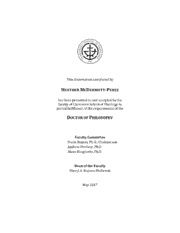
McDermott-Perez - Contemplative Practices: A Neurophysiological Approach to Mediating Compassion Fatigue among Animal Welfare Workers PDF
Preview McDermott-Perez - Contemplative Practices: A Neurophysiological Approach to Mediating Compassion Fatigue among Animal Welfare Workers
CONTEMPLATIVEPRACTICES: ANEUROPHYSIOLOGICALAPPROACHTO MEDIATINGCOMPASSION FATIGUEAMONGANIMALWELFAREWORKERS ADissertation Presentedto TheFacultyof Claremont School ofTheology InPartial Fulfillment oftheRequirements fortheDegree DoctorofPhilosophy by HeatherMcDermott-Perez May2017 Copyright ©May2017byHeatherMcDermott-Perez Thisdissertationcompletedby HEATHERMCDERMOTT-PEREZ hasbeenpresentedtoandacceptedbythe facultyofClaremontSchoolofTheologyin partialfulfillmentoftherequirementsofthe DOCTOROFPHILOSOPHY FacultyCommittee FrankRogers,Ph.D.,Chairperson AndrewDreitcer,Ph.D. AlaneDaugherty,Ph.D. DeanoftheFaculty SherylA.Kujawa-Holbrook May2017 ABSTRACT CONTEMPLATIVEPRACTICES: ANEUROPHYSIOLOGICALAPPROACHTO MEDIATINGCOMPASSION FATIGUEAMONGANIMALWELFAREWORKERS by HeatherMcDermott-Perez Compassionfatigueis a conditionthat affects thoseinvolvedinveterinary medicine, animal rescue andthoseworkinginanimal shelters alike,theconsequences of whichcanleadtoburnout,depression,andeven suicide. Whilecontemplativepractices areoftenmentionedas part ofa cure forcompassionfatigue,nostudies havebeen conductedtomeasuretheirefficacy. This dissertationinvestigates theuseof contemplativepractices as treatment for compassionfatigueamonganimal welfare workers byusingbiofeedbackmachines that measurethebody’s physiological responses toanimal relatedstressors. Apilot studywas conductedinwhichasmall group of animal rescuers, sheltervolunteers andaveterinarytechnicianat an animal oncology centerwererecruitedtoparticipateinan eight-weekexperiment. At theinitial meeting, theparticipants filledout aquestionnaireusedtodeterminelevels of compassion fatigue andburnout. Participants thenwatched atwominutevideodepictinganimals invarious states ofstress whileparticipants werehookedto biofeedbackmachines measuringthe theirrespiratorysinus arrhythmia(RSA),electrodermal activity(EDA),3lead electroencephalogram (EEG),salivarycortisol,andfacial electromyogram (EMG). Participants thenattendedasix-weekcourse wheretheyweretaught several i contemplativepractices aimedat reducingstress. Thestudyconcludedwiththe participants returningtoretakethequestionnaire,fill out anexitsurveyand watchthe videoagainwhilemeasuringtheparticipants’physiological responses. Theresults showedthat thetrendin all measurements, withtheexceptionoftheparticipants’EMG andcortisol results—whichwereinconclusive,was that themajorityofthe participants supportedourhypothesis that stress responses woulddecreaseafter engagingin contemplativepractices. Thetrends from this pilot studysuggest that alargerstudyis merited. Beyondthestudy,thereis reason tobelievethat animal caretakers couldreduce compassionfatiguebyregularlyengagingincontemplativepractices. This couldreduce turnoveramongst animal shelteremployees, veterinarystaff, andanimal rescuers, allowingmore animals toget the caretheydeserve. ii Tomywife,Candy,whoseunwaveringloveandsupport got methroughthis most difficult journey. Toour fourlegged children,Keyser,Candie,Neon,Max,andMona, whoinspiremedaily. Andtoall theinnocent shelteranimals that Icould not save, especiallyBaylee andTink—theyarethe reason Ifight whenthis work gets tough iii ACKNOWLEDGMENTS This dissertationwas madepossibleonlybecause Ihadthehelpandsupport ofthemost amazingpeople. First, IwouldliketothankAlanewho generouslyallowedmydream studytobecome areality,andforneverhesitatingtomentormenomatterhow inconvenient mycalls mayhavebeen. Somanythanks toFrank andAndyforchanging thecourseofmyacademiccareerso manyyears agoand forbeingsomeof thekindest andmost groundedpeople Ihave everhadtheprivilegeofknowing. Iaspiretooneday touchonemystudent’s lives thewayyouhavetouchedmine. Iwant tothankDocFox forbeingourprogram’s most fearless leader,mypersonal cheerleader,coffeedealer, and anall aroundamazingfriend(yes—it’s actuallyin writing). Seth,thank youforall ofour talks about school andjust about lifeingeneral. Also, thank youforbeingthelast minutesourceofknowledgethat has always informedmeabout everythingimportant to academiathat wearesomehowsupposedtoknowbut is neverinwriting. Thank youto Sallyforpickingupmyslackat work whenmymindwas awayat school. Thank you, thank you,thank youto Rhonda,Julie,Christine,MaryandKim. Candy,thank you for allowingmetobe an absenteewifeoverthelast couple years andfor carryingmorethan your fairshareofduties sothat Icouldbeastudent. Ilove you. Mom,Dad,andErin, thank you foralways supportingmeandmakingmesound so muchcooler than Iam when youtalkabout meto your friends. Finally,thank youtoKeyser,Candie,Neon, Max andMonaforalways beingwilling cuddlebuddies when Iam stuckon mycouch studyingandwriting. iv CONTENTS Abstract................................................................................................................................i Dedication..........................................................................................................................iii Acknowledgments..............................................................................................................iv Introduction.......................................................................................................................1 Chapter1:Literature Review..........................................................................................5 Definitionofterms..........................................................................................................6 Animal Caretaker LiteratureReviewed..........................................................................8 HumanCaretaker LiteratureReviewed........................................................................30 Chapter2:ContemplativePractices.............................................................................45 RememberingSacred Moments....................................................................................47 ThePowerofPause......................................................................................................49 TheBreathPractice.......................................................................................................51 Focusing........................................................................................................................54 Internal FamilySystems...............................................................................................58 TheCompassionPractice..............................................................................................61 Chapter3:Neurophysiology..........................................................................................67 TheStress Response.....................................................................................................67 BreakingtheCycle........................................................................................................74 ThePsychophysiologyoftheSix Practices..................................................................75 Chapter4:TheStudy.....................................................................................................93 Methods.........................................................................................................................94 Participants....................................................................................................................94 Procedure......................................................................................................................95 Hypothesis.....................................................................................................................98 DataAnalysis................................................................................................................99 Results.........................................................................................................................103 Post Test Notes...........................................................................................................110 Discussion...................................................................................................................111 Limitations..................................................................................................................112 v Future Implications.....................................................................................................112 Proposed Improvements..............................................................................................113 Appendix A: CSTIRBProposal.....................................................................................120 Appendix B: Consent Form............................................................................................123 Appendix C: PreTest Questionnaire..............................................................................127 Appendix D: Post Test Questionnaire.............................................................................128 Appendix E: ProQOL5 Survey......................................................................................129 Appendix F: SelectedSlideshowPictures......................................................................130 Appendix G: ProQOL5 Results.....................................................................................133 Appendix H: Physiological DataResults........................................................................134 Appendix I: Preand Post Test QuestionnaireResults....................................................135 Bibliography...................................................................................................................136 vi INTRODUCTION Asidefrom myaspirations toresearchandteach contemplativepractices at the undergraduateor graduatelevel,perhaps mygreatest passionis animal rescueand advocacy. Outsideofthe classroom, Idedicateseveral hours a weekvolunteeringat my local animal shelter,socializingdogs not yet readyforadoptionandnetworkingdogs whohaveendedupontheeuthanasialist (otherwiseknownas deathrow), andfostering andeventuallyadoptingapit bull whowas rescuedfrom theeuthanasialist at theshelter where Ivolunteer. Myinvolvement inanimal rescuehas givenmefirst-handknowledge oftheemotional toll thisworktakes onanimal welfareworkers—from sheltervolunteers tokennel attendants toveterinarians. Ihaveseenfriends sufferfrom burnout and compassionfatigue,whicheventuallyledtotheendoftheirvolunteerwork at theshelter. Thesedecisions tostepawaywerenevermadelightlyandresultedinfeelings of guilt, shame,anddisappointment as thesedecisions impactednot onlythepeople whohadto stepawaybut also the animals theycare about so much. As apractical theologian, Isee this as anopportunityto put mytheological trainingtoworkinthe real world. Inhis booktitledAFundamental Practical Theology,DonS.Browningexpands thenotionthat practical theologyis a reflectionof thetask oftheordained ministerand insteaddefines it as the “critical reflectiononthe church’s dialoguewithChristian sources andothercommunities ofexperienceand interpretationwiththeaim ofguiding its actiontowardsocial andindividual transformation.”1 Inshort,we gothroughlife as usual until acrisis arises. At this point, thepractical theologian reflects uponthe 1 DonS.Browning,AFundamental Practical Theology:Descriptiveand StrategicProposals (Minneapolis: Fortress Press,1991),36. 1
